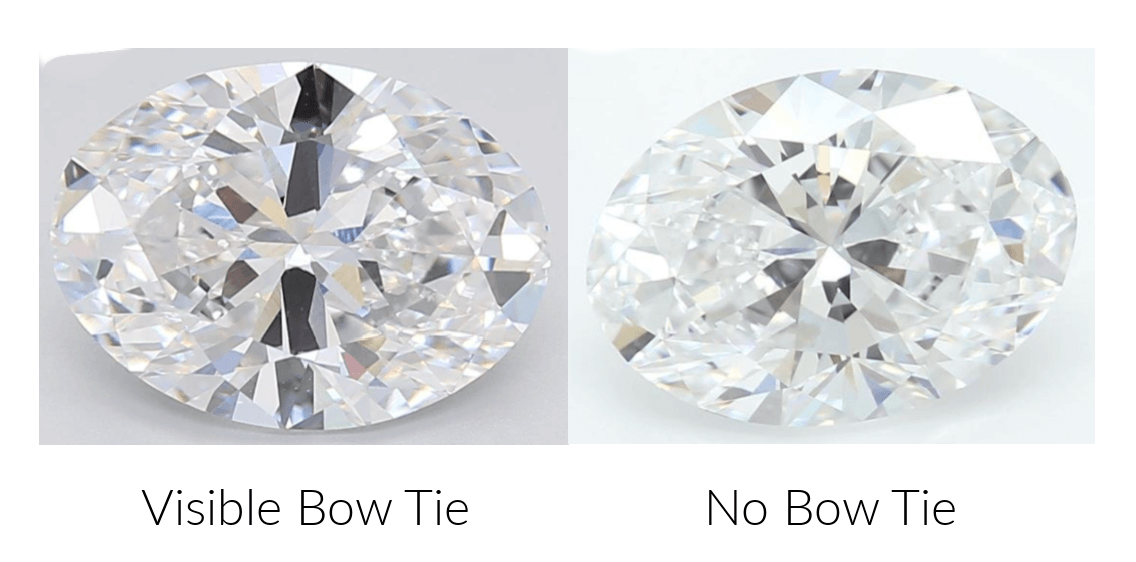Bow Tie Effect In Ovals And How To Avoid Them | Rare Carat
A helpful guide explaining the bow-tie effect in oval diamonds
- The bow-tie effect appears as a dark shadow across oval diamonds
- It occurs when light doesn't reflect properly through the diamond's middle
- Some slight bow-ties can add character to the stone
- Always examine diamonds from multiple angles before purchasing
- Once present, the bow-tie effect cannot be removed
The way an oval diamond is cut can sometimes create something called the bow-tie effect. This is when there is less reflection due to where the facets are placed, and create a shadow that looks like two triangles pointy ends together like a bow tie! While normally this accessory creates a very debonair look, on an oval diamond it is not what you want to be staring at in the middle of your beautiful diamond.
Why does it happen?

Round brilliants are an easy way to compare and understand how facet pattern can create these woeful dark spots on the diamond. RB's are equal in dimension and proportionate all the way around, meaning one that is well cut, has great symmetry and no matter where you look, one side will have a mirror image of facets to the next. Ovals are longer on the ends, and more narrow in the middle. This means the facets may not all be exactly the same. If the middle of the diamond has less facets (meaning less reflective surfaces) this can cause the diamond to look dark and throw the sparkle off.
The whole reason bow ties can come to be, is due to less light reflection internally. The more narrow ends of the oval will produce nice, flattering refraction due to a higher amount of facets in a smaller area, but the middle can become a bummer and produce less light bounding back to you- and creates the dreaded bow tie effect. This is really due to the way the oval is cut. There are a few patterns that the facets can be placed, and it's up to the cutter to make the best call on which set will produce the most equal amount of light refraction.
While the top facets will stay the same as far as pattern, it's underneath where the make-or-break it happens. There are a few options- 4 main, 6 main, and two versions of 8 main patterns. This is how many "main pavilion" facets there are. If you look at the diamond bottom up, you'll notice a star like pattern. This is how many "legs" the star will have! 4, 6 or 8. The more facets you have in the middle area, the more light will be reflected back, reducing the chance of a bow tie.
How do you fix it?
Unfortunately there's no way to get rid of it once it's there. The key here is how obvious it is- sometimes you may only notice it at certain angles, or in certain lighting. Our 360 degree videos really help to address this, as you can view the diamond all the way around, and see if you notice it. While the lighting will stay the same, the angles here are where it'll jump out at you or not.
Are they always bad?

Nope! Sometimes a little bit of a bow-tie will draw in more color and scintillation than the rest of the stone due to the cut. This can create a nice, eye-catching show of sparkle. This doesn't mean the other two ends are any less wonderful, it's just that the slight bow tie is really not causing any harm.
Some people like a bow tie, as it makes the diamond look a little different, but most of the time if they are on the obnoxious side, they are not recommended by jewelers, because there is a chunk of space that is not as dazzling as it possibly could be.
How do you avoid them?
As we went over earlier, one of the best ways to make sure that dreamy oval doesn't have an undesirable bow-tie, is to look at it all the way around in the 360 degree video. This will help ensure that you didn't miss the possibility of there being one in just a stagnant image.
Always feel free to reach out to a gemologist to assist in verifying the diamond you have, to see if it's sporting a (not-so) dashing accessory of bow-tie effect or not. They're the pro's, and will be happy to look it over and give you the thumbs up or down, and offer other options if the one you chose is a no-go.

